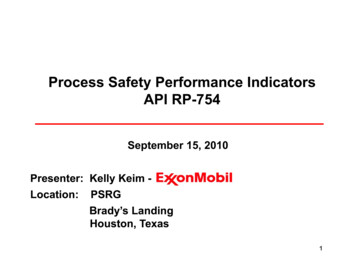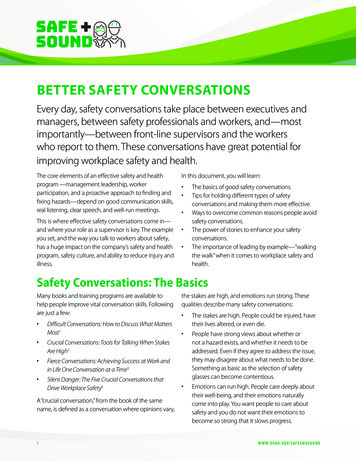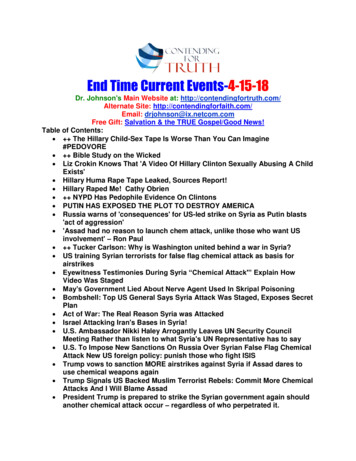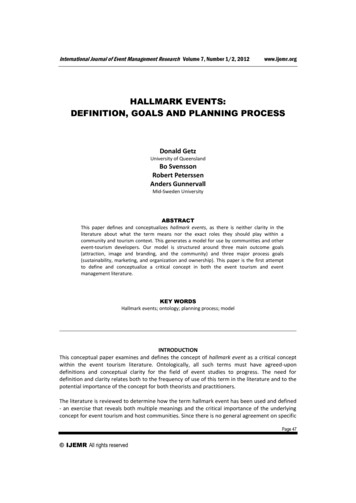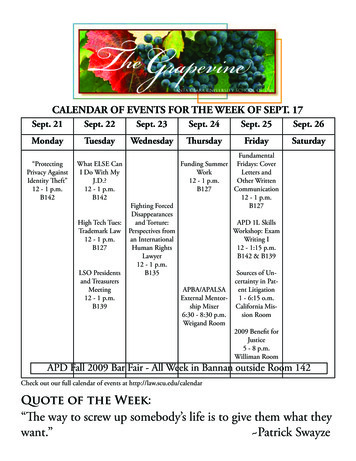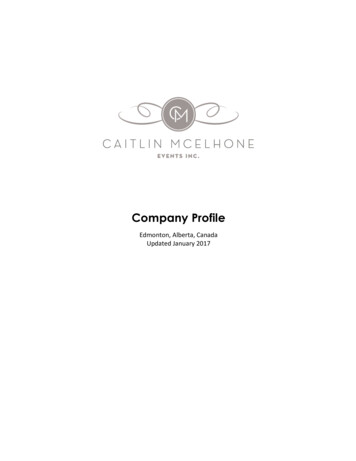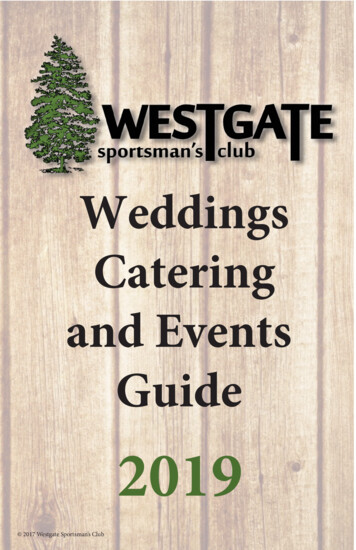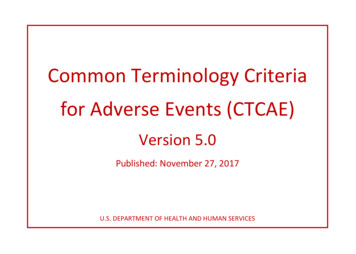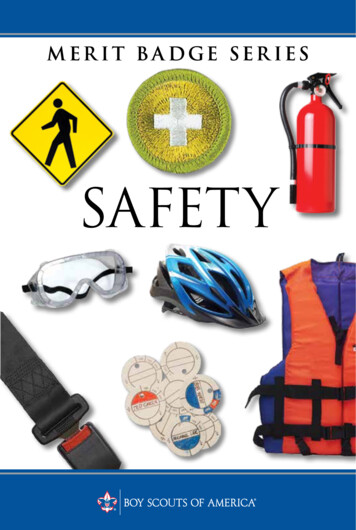
Transcription
SAFETY
BOY SCOUTS OF AMERICAMERIT BADGE SERIESSAFETY“Enhancing our youths’ competitive edge through merit badges”
Safety1. Explain what safety is and what it means to be safe. Then prepare a notebookto include:(a) Newspaper, internet (with parent’s or guardian’s permission), or other articles, facts, and statistics showing common types and causes of injuries in thehome and in the workplace, and how these injuries could be prevented(b) Newspaper, internet (with parent’s or guardian’s permission), or otherarticles, facts, and statistics showing common types of crime and ways toavoid being a crime victim(c) A paragraph or more, written by you, explaining how a serious fire, accident, or crime could change your family life(d) A list of safe practices and safety devices currently used by your family,such as safety practices used at home, while working, and while driving2. Do the following:(a) Using a safety checklist approved by your counselor, make an inspectionof your home. Identify any hazards found and explain how these canbe corrected.(b) Review and develop your family’s fire prevention plan. Review your family’semergency action plan for fire in your home. As you develop these plans withfamily members, share with them facts about the common causes of fire in thehome, such as smoking, cooking, electrical appliances, and candles.3. Do the following:(a) Discuss with your counselor how you contribute to the safety of yourself,your family, and your community.(b) Show your family members how to protect themselves and your homefrom accidents, fire, burglary, robbery, and assault.(c) Discuss with your counselor the tips for online safety. Explain the stepsindividuals can take to help prevent identity theft.(d) Discuss with your counselor the three R’s of Youth Protection and how torecognize child abuse.4. Show your family the exits you would use from different public buildings(such as a theater, municipal building, library, supermarket, shopping center,or your place of worship) in the event of an emergency. Teach your family whatto do in the event that they need to take shelter in or evacuate a public place.
5. Make an emergency action plan for five family activities outside the home (atyour place of worship, at a theater, on a picnic, at the beach, and while traveling,for example). Each plan should include an analysis of possible hazards, proposedaction to correct hazards, and reasons for the correction you propose in each plan.6. Plan and complete a safety project approved by your counselor for your home,school, place of worship, place of employment, or community.7. Explain what the National Terrorism Advisory System is and how you wouldrespond to each type of alert.8. Learn about three career opportunities in the field of safety. Pick one careerand find out the education, training, and experience required for this profession. Discuss this choice with your counselor, and explain why this professionmight interest you.
Safety Resources.Safety ResourcesScouting LiteratureBoy Scout Handbook (including How toProtect Your Children From Child Abuse);Safe Swim Defense; Safety Afloat; ClimbOn Safely; Fieldbook; Crime Prevention,Emergency Preparedness, Fingerprinting,Fire Safety, First Aid, Lifesaving, PublicHealth, Search and Rescue, Traffic Safety,Weather, and Wilderness Survival meritbadge pamphletsVisit the Boy Scouts of America’sofficial retail website at http://www.scoutstuff.org for a complete listing of all merit badgepamphlets and other helpfulScouting materials and supplies.BooksAllman, Toney. Hot Topics: DistractedDriving. Lucent Books, 2015.American Red Cross. First Aid/CPR/AED Participant’s Manual.Staywell, 2014.American Red Cross. Responding toEmergencies. Staywell, 2012.American Red Cross. Wilderness andRemote First Aid. Staywell, 2010.78SAFETYAre You Ready? An In-Depth Guideto Citizen Preparedness (IS-22).FEMA, 2013. Order a free copyat 800-480-2520.Dadd, Debra Lynn. Home Safe Home.Penguin Publishing Group, 2005.Heberle, David, and Richard Scutella.The Complete Guide to Making YourHome Safe. Betterway Books, 1998.Morkes, Andrew, ed. Careers inFocus: Public Safety, 3rd ed.Ferguson Publishing, 2007.Vacca, John, and Mary E. Vacca.Cybersafety: Identity Theft. ChelseaHouse Publishing, 2012.Warde, John. The Healthy HomeHandbook: All You Need to Know toRid Your Home of Health and SafetyHazards. Three Rivers Press, 1997.Organizations, GovernmentAgencies, and WebsitesAAA Foundation for Traffic SafetyTelephone: 202-638-5944Website: http://www.aaafoundation.orgAmerican Association of PoisonControl CentersToll-free hotline: 800-222-1222Website: http://www.aapcc.org
.Safety ResourcesAmerican Red CrossToll-free telephone: 800-733-2767Website: http://www.redcross.orgAmerican Society ofSafety EngineersTelephone: 847-699-2929Website: http://www.asse.orgASTM InternationalToll-free telephone: 877-909-2786Website: http://www.astm.orgChurch Mutual InsuranceToll-free telephone: 800-554-2642Website: http://www.churchmutual.comFederal EmergencyManagement AgencyToll-free hotline: 800-621-FEMAWebsite: http://www.fema.govFM Global (FM)Website: http://www.fmglobal.comNational Fire Protection AssociationToll-free telephone: 800-344-3555Website: http://www.nfpa.orgNational Highway TrafficSafety AdministrationToll-free telephone: 888-327-4236Website: http://www.nhtsa.govNational Safety CouncilToll-free telephone: 800-621-7615Website: http://www.nsc.orgOccupational Safety andHealth AdministrationToll-free telephone: 800-321-OSHAWebsite: http://www.osha.govReady CampaignFEMA/U.S. Departmentof Homeland SecurityWebsite: http://www.ready.govSafe KidsTelephone: 202-662-0600Website: http://www.safekids.orgUnderwriters Laboratories Inc. (UL)Telephone: 877-854-3577Website: http://www.ul.comU.S. Consumer ProductSafety CommissionToll-free hotline: 800-638-2772Website: http://www.cpsc.govU.S. Department ofHomeland SecurityWebsite: http://www.dhs.govU.S. National Library of MedicineWebsite: http://www.nlm.nih.govAcknowledgmentsThe Boy Scouts of America is gratefulto the following for their assistance inpreparing the 2006 edition of the Safetymerit badge pamphlet. Members of the Safety merit badgereview committee, in particularSven Rundman (chair), NormanButman, Mike Donaghue, EdHaywood, Glen Henderson;Tom Seymour, and Tom Watson Members of the BSA Health andSafety Committee, in particularDavid Bell, Ph.D.; William W.Forgey, M.D.; John E. Hendrickson,American Red Cross NationalHeadquarters; Charles Mitchell,National Rifle Association ofAmerica; Arthur H. Mittelstaedt Jr.,Ph.D., Recreation Safety Institute;and Paul Young, R.S., M.P.H.Thanks also to Bryan Caldwell,retired captain, Hawaii County FireDepartment; Michele Campbell andKevin Fearn, Research and StatisticsDepartment, National Safety Council;and Ralph W. Russell II, Institute ofElectrical and Electronics Engineers.SAFETY79
American Red Cross. First Aid/CPR/ AED Participant’s Manual. AAA Foundation for Traf Staywell, 2014. American Red Cross. Responding to Emergencies. Staywell, 2012. American Red Cross. Wilderness and Remote First Aid. Staywell, 2010. Are You Ready? An In-Depth Guide to Citizen Preparednes


